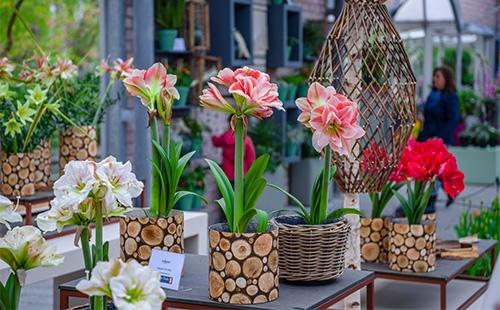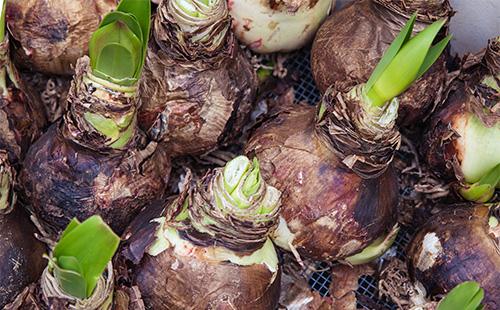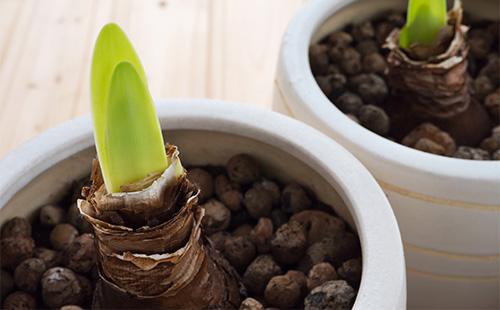The content of the article
Hippeastrum (Latin name - Hippeastrum) belongs to the amaryllis family, perennial. This bulbous plant is often mistakenly called amaryllis, but experienced flower growers know everything about their differences.
Botanical characteristics and differences from amaryllis
Amaryllis exists in only one form - Amaryllis belladonna or Amazing beautiful. Hippeastrum, unlike its close relative, has 80 main species, 2 thousand varieties and over 600 hybrids. Outwardly similar, these flowers have biological differences, which are presented in the table below.
Table - Botanical characteristics and differences of hippeastrum and amaryllis
| Specifications | Hippeastrum | Amaryllis |
|---|---|---|
| Origin | - Tropical America | - South Africa |
| Peduncle structure (main distinguishing feature) | - Hollow; - reaches 90 cm; - predominantly green | - full-bodied; - height up to 96 cm; - crimson shade |
| The number of flowers in a bud | - From 2 to 6 (some species may have 15) | - from 8 to 12 |
| Smell of flowers | - Missing or mild | - Has a delicate, delicate aroma |
| Flower color | - snow white; - red; - purple; - yellow; - green; - Orange; - cream; - with stripes; - interspersed with; - with colored veins | - Mostly pink |
| Flower shape | - Terry; - orchid-like; - tubular and others | - funnel |
| Flower size | - Depends on grade: from 5 to 22 cm | - from 9 to 13 cm |
| Leaves | - Belted, fleshy, dark green; - glossy or matte; - maximum length - 90 cm; - thickness - from 3 to 5 cm | - Narrow, shiny, emerald green; - length - up to 60 cm; - maximum thickness - 3.5 cm |
| Peduncle formation | - After the fourth sheet or with it | - Blossom leafless (flower stalk first appears, by the end of flowering - foliage) |
| Bulb | - Symmetric; - round or conical; - looks like a bulb of a daffodil | - pear-shaped |
| Stage of rest | - End of summer - through October-November | - from June to September |
| Bloom | - The end of autumn - February-April | - Late autumn, closer to winter |
Variety of varieties
Breeders managed to bring a huge number of varieties of hippeastrum.They are classified by the size and shape of the flower. Thus, the plants are divided into nine groups: simple large, medium, and small-flowered, three terry groups with similar flower sizes, sibisters, orchid-like and tubular hybrids. Brief descriptions of popular species can be found in the table.
Table - A Brief Description of Popular Types of Hippeastrum
| Grade | Group | Short description |
|---|---|---|
| Lady Jane | - Terry large-flowered | - Gentle peach corrugated flowers with pink and yellow splashes; - diameter of flowers - up to 20 cm |
| Barbados (one of the most striking views) | - Terry large-flowered | - Red-burgundy flowers with central stripes of white color; - inside the flower 6 curved pistils |
| Papilio Butterfly | - Orchid-like | - Oblong bulb; - the flower looks like a butterfly; - creamy, yellow-green color with central bright raspberry stripes |
| "Parrot" | - Hybrid | - grows to 90 cm; - large onion; - leaves with a gray tint; - cherry flowers with oblong, sharp petals |
| "Charisma" | - Large-flowered simple | - Red flowers with white hatching around the edges; - the stamen and pestle are also red; - flower diameter - up to 23 cm |
| "Reticulate" | - Hybrid | - Length - up to 0.5 m; - a small onion; - thin leaves; - claw-shaped petals; - lilac-pink flowers; - a lot of dark veins |
Hippeastrum Care
Suitable conditions for growing hippeastrum especially in autumn are the optimal combination of temperature, light, humidity level, which are absolutely opposite during periods of growth, flowering and dormancy. On how to care for hippeastrum, its decorative beauty depends.
Temperature
Hippeastrum develops at any room temperature, however, 20-25 ° C is considered the most comfortable for the plant. Avoid sudden temperature changes that slow down flower growth. During the resting period of the plant (temporary data are in the table with botanical characteristics), do not allow the temperature to drop below 10 ° C.
Illumination
Hyperarum is a sun-loving flower, it is advisable to place it on the southeast and southwest windows. It normally tolerates direct sunlight, but it is better to provide the hippeastrum with diffused light through a transparent tulle. Eight to ten weeks a year, the plant spends in a darkened place, in cool (12-14 ° C). This is a period of rest. To hippeastrum woke up, the pot is placed on a bright window.
Proper watering
The amount of moisture depends on the stages of plant vegetation. With the beginning of the "hibernation" period, watering is stopped until the leaves completely dry. Only a small amount of water is allowed in the pan to maintain the viability of the bulb and roots. At the time of awakening, the amount of moisture is increased to moderate (watered no more than twice a month). With the development of the peduncle, watering the hippeastrum should be systematic and take into account the following features of the procedure:
- use only warm water;
- do not overmoisten the soil;
- make sure that the earthen lump between the irrigations has time to dry out;
- prevent water from getting on the bulb.
Humidity
Hippeastrum, although it grows in the tropics, is a lover of dry maintenance. He does not need spraying and irrigation, since at high air humidity stagonosporosis quickly spreads. This is one of the most dangerous diseases for indoor hippeastrum. At the same time, it is recommended to wipe its juicy, fleshy leaves from the dust with a moistened cotton pad.
Priming
Effective cultivation requires light and loose soils with high rates of air and moisture permeability.The following earthen substrate is ideal: peat, river sand and drainage or deciduous land in equal proportions. A simple solution is to purchase shop soil for begonia. After two or three years, it is desirable to completely renew the soil.
Top dressing
Top dressing is very important as the bulb accumulates vitality for future flowering. Hippeastrum is fertilized every ten days (except for the rest period). Use potash fertilizers, the composition of which depends on the stage of plant life:
- beginning of vegetation - nitrogen-potash in a proportion of 40:60;
- peduncle formation - nitrogen-phosphorus-potassium top dressing in the ratio of 30:30:40;
- flowering time - phosphorus-potash fertilizers in a ratio of 40:60.

Container for growing
The diameter of the bulb of the hippeastrum is an average of 10 cm, it has long roots. To grow a flower, you need a narrow and tall pot, preferably ceramic. Focus on such dimensions: depth - up to 15 cm, width - 5 cm more than the diameter of the bulb. The bottom of the pot must be filled with drainage.
Transfer
It is better to transplant the hippeastrum in the early spring, while completely renewing the soil. The location of adult plants is advised to be changed every two to three years. In summer, the bulbous flower can be transferred to the open ground, and with the advent of autumn, return it to its place. In the first half of September, the plant is dug up, dry flakes are cleaned and necessarily treated with copper-containing solutions. The transplant procedure must be performed very carefully so as not to spoil the voluminous leaves.
Purchase and acclimatization in new conditions
Hippeastrum cultivation begins with the acquisition of a plant in a flower shop.
The bulb of a healthy flower is as follows:
- top scaly layer - smooth, dry, evenly colored, brown;
- bulb - dense, without spots and seals;
- leaves (if any) - uniform coloring, without spots;
- the roots - white (usually they look through the drainage holes).
If the bulb is healthy ...
Caring for hippeastrum after purchase involves placing the plant in partial shade and isolated from flowers, "old-timers" for about a couple of weeks. If you bought only a hippeastrum bulb, follow these three simple steps.
- Treatment. We clear the acquired onion of dried scales and treat with fungicides. This can be either a finished store drug or Bordeaux liquid (a combination of copper sulphate and hydrated lime).
- Landing. Next, you need a shallow landing in a narrow and tall pot with moist earth mixture. We deepen the bulb to a large part of its height, one third should be on top of the soil.
- The choice of place. We put the pot in a bright, warm place and do not water it until the first shoots.

... and if "problematic"
If planting material is spoiled, do not rush to get upset. The following five-step instruction will help prepare and plant even a slightly damaged bulb.
- Resuscitation of the roots. Damaged roots are carefully trimmed and sprinkled with slice ash or cinnamon. Do the same with too long roots.
- Removing damage. Visually damaged areas of the bulb and damage are also cut off.
- Treatment. You can improve the onion by placing it in the “Fundazole” solution for half an hour. Fungicide can be replaced with ordinary green.
- Drying out. Before planting, dry the bulb for 24 hours.
- Landing. Next, we act similarly to the previous instructions.
Why does not bloom: reasons and decisions
It would seem that the plant was planted with caring hands, receives decent care, and refuses to bloom. Five reasons can be identified.
- Bulb depletion. During the growing season of the hippeastrum, the soil depletes very quickly, because the plant needs a huge supply of nutrients. Regularly feed.
- The appearance of "children." Hippeastrum spends all its efforts on the cultivation of "offspring." Small onions are cut, and the “wounds” are treated with ash.
- Insect pests. Hippeastrum wastes its strength in combating a spider mite, a worm or a scale insect.
- Bulb rot. Overmoistening of the earth causes rotting of the bulb. As a result, hippeastrum does not bloom.
- Bad light. There is no flowering, because during intensive growth the flower lacked light.
3 tricks of experienced gardeners
If you analyze the feedback from experienced gardeners, you can note three tricks that will make hippeastrum bloom.
- Hot processing. Place the onion in hot water (45ºC). After three hours, land. After this treatment, the plant will bloom after three to four weeks.
- Six months of hibernation. From August to the end of January, keep the hippeastrum in a dark, dry place. Stop watering. Then bring to light, resume watering. Flowers will appear in a month and a half.
- Extra nutrition. In July, you need to cut off all the leaves and stop watering for a month. With the first watering, introduce complex fertilizer. The plant will bloom in late August-September.
Care after flowering: 4 rules
It is equally important to know how to care for hippeastrum after flowering, since then the foundation for further plant growth is laid. The following four rules will benefit the plant.
- We remove the flower.A withered flower needs to be cut.
- Cut the leaves. Carefully bend the leaves with your palms, and after yellowing, prune.
- We transplant. A month after flowering, hippeastrum can be transplanted into new soil (judging by the reviews, many flower growers do this).
- Cooking for the dormant stage. Watering and fertilizing continue, preparing the plant for a long rest, that is, to the stage of dormancy. During this period, the hippeastrum will not give visible "signs of life." All processes (the development of leaves and peduncles) occur in the middle of the bulb.
Pests and diseases
Bulbous plants, which include hippeastrum, are susceptible to disease. Pest insects bother him.
The main cause of hippeastrum diseases is abundant watering, as well as sharp temperature drops, improperly selected earth mix, excessive norm of nitrogen fertilizer. From the emergence of new foci of stagonosporosis, the transplantation of the plant into another pot and the renewal of the soil will save.
Understand what is happening with the plant, you can four external signs.
- Spots and cracks in the peduncle. Gray rot develops. Fungicide treatment required.
- Yellowing leaves. Hippeastrum leaves turn yellow or the color of the flower changes if the plant is affected by aphids, thrips. For treatment, systemic insecticides are used (Fitoverm, Vertimek, Artelik).
- Red or yellow dots on the leaves. They were caused by a spider mite. They get rid of it with acaricides.
- Stains and dots of red on the bulb. A sign of a dangerous disease of stagonosporosis or a red burn, which must be fought instantly and radically, otherwise the plant will die. All infected and dubious places are cut out, including leaves and roots.Bulbs are treated with copper-containing or fungicidal preparations. Effective "Fundazole" or "Fitosporin." In addition to these traumatic procedures, there is no other way to reanimate the hippeastrum.

Breeding
Hippeastrum propagated by seed and vegetative methods. The first is considered quite long, energy-consuming and ineffective, since it does not guarantee the preservation of maternal cells by the flower. The second is a more common and effective option. He suggests two methods: reproduction by "children" or dividing the bulbs.
Seeds
Basically, the propagation of hippeastrum by seeds is chosen by breeders, because you need to pollinate the plant yourself, artificially. Seedlings after a successful procedure will appear in a couple of months.
Only freshly picked seeds give one hundred percent germination. Therefore, it is important to set deadlines in order to plant them in the sandy-deciduous soil in spring. Shoots will appear on about 15-20 days. A plant grown in this way will bloom in about the fourth to fifth year.
"Kids"
Features This is a natural, and therefore the most favorable way. Three-year-old bulbs of hippeastrum with proper care give three “babies” that grow on the sides of the mother’s bulb. We transplant "children" in five stages.
- Carefully separate the small bulbs from the main one.
- Sprinkle the place of separation with charcoal or activated carbon or ash.
- We plant in the prepared soil, deepening the bulbs at half their height.
- Until the first leaves (one and a half to two months), the soil is kept in a wet state. These are optimal conditions for the formation of a strong root system.
- Bulbs with young leaves are transplanted into separate pots.
Bulb Division
Florists are increasingly practicing this method of breeding hippeastrum. However, this method is quite risky, because an infection can get into the wound (the incision site). In this case, the transplant involves the following five steps.
- Choose an adult, healthy onion.
- Cut in half, leaving on each slice equal parts of scales and roots.
- Sprinkle a fresh slice of charcoal.
- We plant the halves in a peat substrate.
- After the appearance of "children" (maxim in a couple of months), we plant them in separate containers.
Growing hippeastrum at home has its own specific features, but novice florists may well master the care and propagation of this beautiful decorative flower. If you decide to grow a full-fledged flowering plant yourself from daughter bulbs, be patient. The first two years, young hippeastrum is not deprived of leaves and sent to rest: the growth of the bulb and the formation of buds in it will depend on the intensity of leaf growth. The first flowers of extraordinary beauty, towering above the juicy leaves, hippeastrum will delight in three years.

